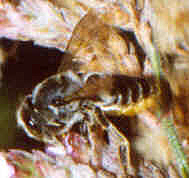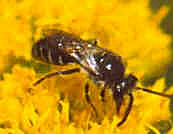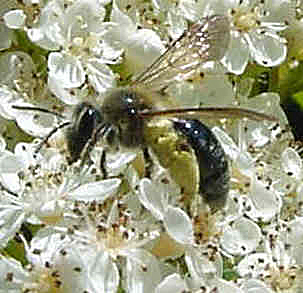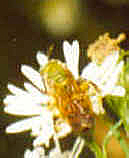What's Buzzin'
in My Garden?
"I don't know a bee from a wasp, a hornet, or a yellow
jacket."
(These are pictures from the eastern USA, your garden may have different species.)
For more information on
each of these, click the links provided, or go back to home page
and run a search, either at the pollination page site or on the internet.
Images are copyright, use without
permission is theft
Stings: One of the first
concern for many folks is whether these creatures will sting. Many can sting, but stinging
is most likely when you disturb the nest of a colonial species, like honeybees, hornets,
social wasps, and bumblebees. Solitary species rarely sting, and only under extreme
provocation. No bee will sting when they are visting flowers, unless you grab ahold of
them. If you don't run barefoot thru the dandelions and clover, and don't mess with their
nests, you have little to worry about. If you are truly allergic (and a whole lot more
folks think they are, than really are), carry a sting kit at all times. You cannot
"bee-proof" the world; if you could it would be a world rife with famine.
Haaalp, I've Been Stung by a "Bee."
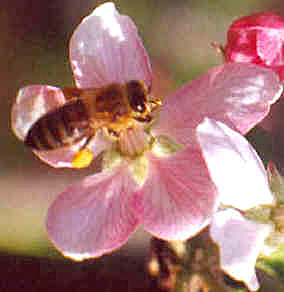
|
Honeybee
On apple
This used to be the most common
visitor to home gardens, and still may be, if you have a beekeeper nearby.
This fuzzy gal, seen on an apple blossom here, is an excellent all around
pollinator. You can see one of the pollen pellets on her back legs here.
Some folks hold it against her that she's not native to North America,
but hey, most of our food crops aren't native either. |
A
honeybee's mother
(At right)
Though rarely seen by most
gardeners, you will learn to identify the queen if you keep bees
for your garden pollination. She normally stays inside the hive, except on her mating flights, and possibly at swarm time in
the spring.
Pollination
For the Home Gardener by Veatch
Learn about honeybee biology by
Keith Delaplane
More Resources for Beginner Beekeepers |
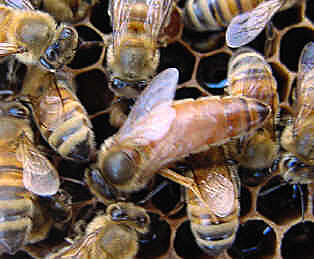
|
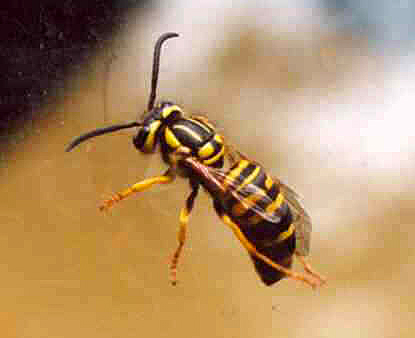
Vespula squamosa
Southern Yellow Jacket
|
Yellow
Jacket
(At Left)
Often called a bee by novices,
she doesn't really resemble one, if you look closely. A honeybee is fuzzy, with muted tans
and browns. A yellow jacket (a wasp) is shiny yellow and black striped. A lot of
"bee" drawings in the popular press actually are drawings of yellow jackets.
These are the pests that get into your can of soda at your Labor Day picnic.
Yellow jackets don't visit flowers much; they mostly catch other
insects. When they do visit flowers, they only accomplish a little pollination, because
they aren't fuzzy. More on wasps below. |
Bumblebee
On star thistle
She's fuzzy all over, and one of
the most important pollinators. You probably won't see her in the spring, but she's can be
around in great numbers by midsummer. Bumblebees live in colonies and the colonies don't
survive the winter, so you only see an occasional queen in the spring.
|
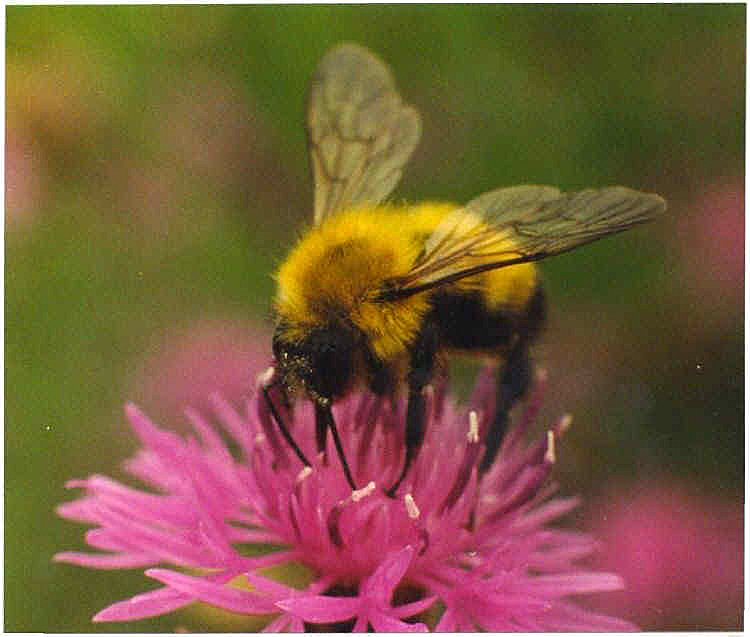
|

Xylocopa virginica
|
Carpenter
Bee
On holly (at left)
She's often mistaken for a
bumble bee, but is easily distinguished by her shiny black butt, instead of a fuzzy gold
and brown butt.
Carpenter bees are much maligned because they bore into wood to make
their nests, but they are valuable pollinators and should be protected. Usually the damage
they do to wood is just cosmetic.
They pollinate many spring flowers, though they sometimes slit blueberry
flowers and steal nectar without pollinating them.
Carpenter bees are solitary bees, with each lady making her own nest.
They are most common in early spring. |
Drone
Carpenter Bee
(Notice white spot on his head)
Some folks are terrified of this
buzzer. You won't see him visiting flowers and minding his own business like the female.
Rather he'll be looking you over to see if you are sexy. Drones have a territory that they
watch, and anything within it that moves, will be investigated.
There is not an ounce of aggression in this harmless fellow's body, except
toward other drones. He cannot sting you anyway. So when he comes to buzz around you, look
him straight in the eye and dance with him. Toss a pebble and watch him chase it. Look
cross eyed, or stick out your tongue at him. See, all he'll do is a friendly buzz game.
This is an ideal chance to teach your kids one of the joys of nature, rather than load
them up with wasted fear of something completely harmless.
PLEASE PROTECT
THESE GENTLE, GIANT POLLINATORS!
Drone Carpenter: Close Up View |
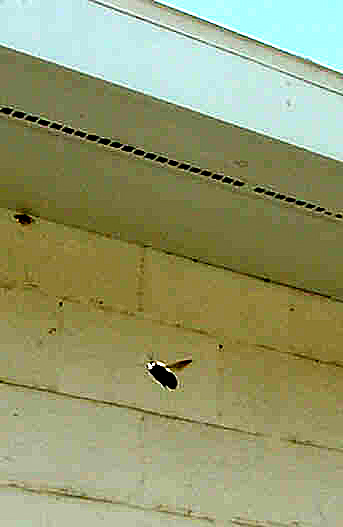
|
Hoverfly
or Syrphid Fly
Hey, I KNOW the picture is
fuzzy. But I'm lucky to get a picture at all, of this tiny fast-moving gal. She's usually
seen hanging in mid air in front of the flower. Then she'll dart in for a sip of nectar.
You can see her briefly hold still in the picture below.
She does do some pollination, but not as efficiently as the fuzzy
honeybee or bumblebee. Stingless... |
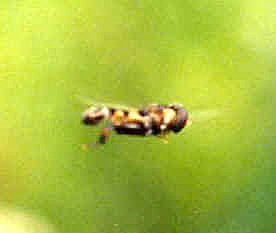
|

|
Syrphid
fly
On chicory (at left)
This bee mimic is often
seen visiting flowers, and does accomplish some pollination. It only has one pair of
wings, not two, as do bees. The striped abdomen may be a clever adaptation to fool
preditors into thinking she's a bee and might sting. Actually she is stingless.
|
Drone
Fly
On aster
This gal can be an
excellent pollinator. She has very large eyes thus mimicking the honeybee drone, but she's
a fly, with only one pair of wings, not a bee, with two pairs.
|
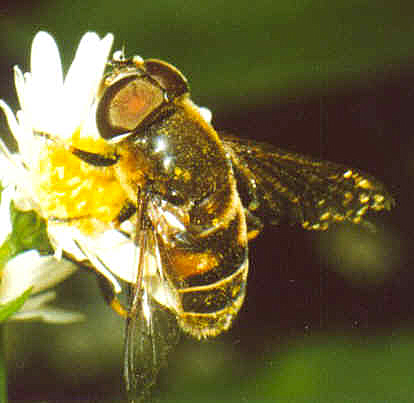
|
Solitary Bees
There are thousands of species (actually carpenter bees are solitary too).
Many are good pollinators. None are a threat to humans. Here are a few
representatives.
Lots more on Solitary Bees as Alternative
Pollinators
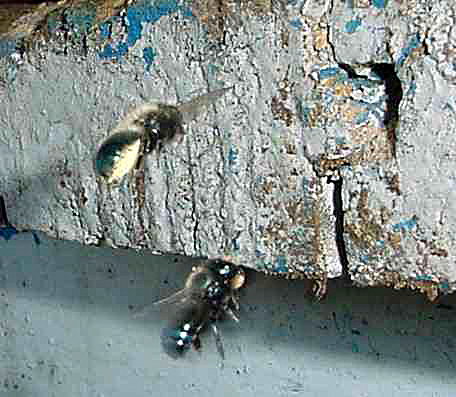
|
Mason Bees
Megachilidae
entering their homes in cracks in tongue
and grove lumber. These solitary bees are quite gregarious. In other words, each female
makes her own nest, but they like to nest near each other. Note pollen on one's
"belly," which will be used to provision the young for next year.
You can provide nesting
sites for these gentle bees, which are excellent pollinators for spring fruit. They are
dormant in the summer time. |
Pollinator Paradise (All about
solitary bees)
White
Faced Hornet
This gal will sometimes visit
flowers, especially in the fall, when goldenrod blooms. She's a so-so pollinator then, but
a wonderful pest control agent for most of the summer. She and her sisters prefer
caterpillars for their lunch, and many caterpillars are the worst garden pests. |
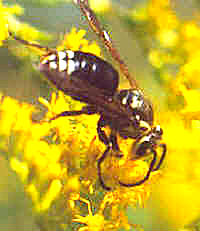
Dolichovespula maculata
|
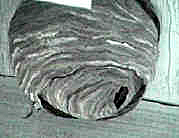
Hornet nest
Don't Mess with
the Nest!
Our Hornet Nest kept our garden clean of worms
Hornetboy's photo
gallery |
Wasps
There are thousands of wasp species. Larger ones usually prey on pest insects or
spiders. Many of the smaller ones are parasites of pests in their larval stage. Most wasps
are beneficial, and are quite gentle. Only yellow jackets and the larger nests of social
wasps are likely to sting.
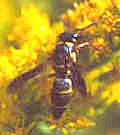
|
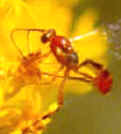
|
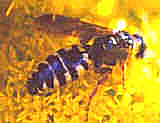
|

|
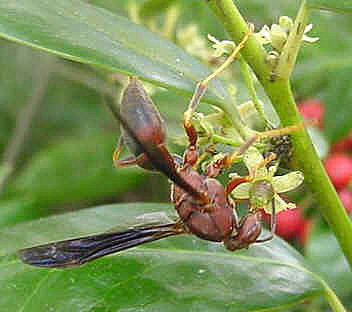 |
Potter wasp |
Ichneumon wasp |
Tiphiid wasp |
Grasshopper hunter |
Paper Wasp |
Tachinid Flies
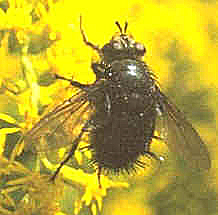
|
Some tachinid flies
resemble bees, as the one at left (called a "bee fly"); others don't, as at
right. Most are beneficial because they parasitize pest insects. They also do some
pollination. |
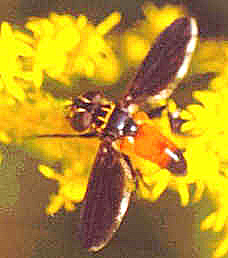
|
Photos of many
hymenopteran species MN
Thanks to Eric Eaton and others for
help in identification.
Home









